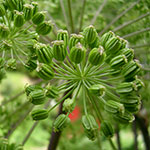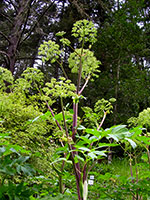Angelica, Garden Angelica
Angelica archangelica
family:Apiaceae
 note: In addition to the European Angelica archangelica, there are many wild species of Angelica in North America, as well as the Chinese medicinal Dong Quai (Angelica sinensis) and the Japanese Ashitaba (Angelica keiskei). They all have varying and similar medicinal properties - this monograph will refer to Angelica archangelica, a native of Northern Europe and Syria that is cultivated throughout Europe, the USA and beyond.
note: In addition to the European Angelica archangelica, there are many wild species of Angelica in North America, as well as the Chinese medicinal Dong Quai (Angelica sinensis) and the Japanese Ashitaba (Angelica keiskei). They all have varying and similar medicinal properties - this monograph will refer to Angelica archangelica, a native of Northern Europe and Syria that is cultivated throughout Europe, the USA and beyond.
the plant: Angelica is a tall, aromatic perennial in the parsley family that has been cultivated since ancient times. With its serrated leaflets gathered in giant parsley-shaped bipinnate aromatic leaves, the plant in its second year sends up a grand, fluted, tubular stalk, topped with a grapefruit-sized spherical umbol of flowers. The stalk is between 1 and 2 meters high and its flowers explode into fireworks of many tiny white or softly pink flowers that mature into a dense sphere of round, winged, segmented & spicy seeds.
It likes to dwell in damp places, especially along streams rivers and seashores, on sites where there is plenty of sunlight. Angelica has a thick taproot and bright green stems that are sometimes tinged with purple.
 parts used: Root, seeds, leaf.
parts used: Root, seeds, leaf.
medicinal actions: Carminative, antimicrobial, expectorant, tonic, antispasmodic, diaphoretic, diuretic.
preparation: Tincture, decoction, chew seeds or root.
contraindications: None
 indications: Angelica is a warming, decongesting and aromatic bitter. Its essential oils, bitters and coumarins make it a broadly useful medicinal plant ally. Angelica appears in traditional digestive apertífs and has been used for centuries as a digestive aid. Its bitter aromatic warming qualities can help with indigestion, bloating, sluggish liver or gas. It can also help stimulate appetite and can be an ally in working with anorexia.
indications: Angelica is a warming, decongesting and aromatic bitter. Its essential oils, bitters and coumarins make it a broadly useful medicinal plant ally. Angelica appears in traditional digestive apertífs and has been used for centuries as a digestive aid. Its bitter aromatic warming qualities can help with indigestion, bloating, sluggish liver or gas. It can also help stimulate appetite and can be an ally in working with anorexia.
Angelica also helps stimulate blood and circulation, and is especially regarded as a women's herb in this way. Angelica relieves menstrual cramps by warming, relaxing, decongesting, and stimulating flow. It can also be useful in regulating cycle or bringing on delayed menses. It has been used during birth as a tonic, and after childbirth, to help expel the placenta. 
Angelica has a warming expectorating effect on the lungs and can help soothe and heal coughs, bronchitis and pleurisy, especially when they come along with a cold or flu. The leaf can be used as a compress for inflammations of the chest. Angelica has been used across time and cultures to purify and protect against disease, and can be used as a remedy for viral infections such as influenza and the common cold. It is also used to treat bladder infections and rheumatic conditions.
Angelica also went by the name of Holy Ghost, and according to legend, was revealed to a 14th century monk by the Archangel as a medicine plant that could help with the plague. Angelica has been celebrated for centuries for its magical properties. In Northern Europe, where Angelica archangelica grows wild, the plant has been used as food and medicine since at least the 10th century.
Its wild North American relatives have been used widely for medicine by people native to this land since before Europeans arrived. A relative of Osha, it is considered by some native peoples to be strengthening, rejuvenating 'Bear medicine,' the "Osha del Campo".
contraindications: Not for use during pregnancy. Topical exposure may cause photosensitivity and  blistering. Avoid sun exposure followed by skin exposure to plants juices or essential oil.
blistering. Avoid sun exposure followed by skin exposure to plants juices or essential oil.
primary references:
• Buhner, Stephen Harrod. Sacred Plant Medicine
• Culpepper. The Complete Herbal
• Glastar, Rosemary. Herbal Healing for Women
• Grieves, Maude. A Modern Herbal
• Hoffmann, David. Medical Herbalism
• Moore, Michael. Medicinal Plants of the Pacific West
• Wood, Matthew. The Book of Herbal Wisdom
• Ward, Harold. Herbal Manual (via Michael Moore's website)
note: This information is not a replacement for a trained herbalist. Please consult your medical professional before treating yourself or others with this or any other herbal remedy.